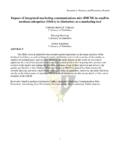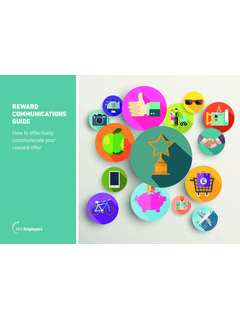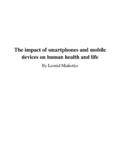Transcription of The impact of mobile learning on students' learning ...
1 British Journal of Educational Technology Vol 40 No 4 2009 673 695. The impact of mobile learning on students' learning behaviours and performance: Report from a large blended classroom Minjuan Wang, Ruimin Shen, Daniel Novak, Xiaoyan Pan Minjuan Wang is an associate professor of Educational Technology at San Diego State University. Her research specialties focus on the sociocultural facets of online learning , mobile learning and technological interventions in language education. She has published peer-reviewed articles in Educational Technol- ogy Research and Development, Computers and Education, Educational Media International, TechTrends, and the British Journal of Educational Technology. She has also published book chapters on engaged learning in online problem solving, Cybergogy for interactive learning online, informal learning via the Internet, and effective learning in multicultural and multilingual classrooms.
2 Address for correspondence: Dr Minjuan Wang, 5500 Campanile Dr. North ED 280, SDSU, San Diego, CA 92182. Tel: 619-5943878 Email: Ruimin Shen is distinguished professor of Computer Science and Engineering at Shanghai Jiaotong University (SJTU). He is also the founder and director of the world-renowned E- learning Lab, and the founding dean of SJTU's Network Education College (17 000 students). Shen's research and development specialty focus on cutting-edge technologies for available anywhere and updatable anytime' distance education, including mobile learning , standard natural classrooms and knowledge discovery and data mining. He has peer-reviewed articles published in International Journal of Distance Education Technologies, Lectures Notes in Computer Science, British Journal of Educational Technology, Computers and Education, etc. Address for correspon- dence: E- learning Lab and Network Education College, Shanghai Jiaotong University, Haoran High-tech bldg.
3 , 6th Floor, Hua Shan Road, Shanghai, China. Email: Daniel Novak is an MA. candidate of Educational Technology, San Diego State University. His research focuses on gender differ- ences in technology-supported learning settings. He received his BA from University of California, Santa Barbara in Art History, and completed a departmental Honors Thesis in Punk Art of the 1970s and 1980s. Address for correspondence: Educational Technology, San Diego State University. Email: Xiaoyan Pan is an associate professor of English at Shanghai Jiaotong University (SJTU) and a prolific author of 50 English books, such as College English Synonyms and Handbook for Advanced Interpretation. She teaches major English courses at the Network Education College, including Intensive Reading, Extensive Reading, Writing and English Speaking. Placing great emphasis on class interactions, she conducts action research on the use of new and innovative systems in her classrooms.
4 She has several papers accepted by international conferences in e- learning and distance education. Address for correspondence: Network Education College, Shanghai Jiaotong University, Haoran High-tech bldg., 6th Floor, Hua Shan Road, Shanghai, China. Email: Abstract Chinese classrooms, whether on school grounds or online, have long suffered from a lack of interactivity. Many online classes simply provide recorded instructor lectures, which only reinforces the negative effects of passive nonparticipatory learning . At Shanghai Jiaotong University, researchers and developers actively seek technologic interventions that can greatly increase 2008 The Authors. Journal compilation 2008 British Educational Communications and Technology Agency. Published by Blackwell Publishing, 9600 Garsington Road, Oxford OX4 2DQ, UK and 350 Main Street, Malden, MA 02148, USA. 674 British Journal of Educational Technology Vol 40 No 4 2009.
5 Interactivity in large blended classes. They developed a cutting-edge mobile learning system that can deliver live broadcasts of real-time classroom teach- ing to students with mobile devices. Their system allows students to customise means of content-reception based on when and where they tune into the broadcast. The system also supports short text messaging and instant polls. Through these venues, students can ask questions and make suggestions in real time, and the instructor can address them immediately. This article describes this system in detail, and also reports results from a formal imple- mentation of the system in a blended English classroom of 1000 students (with about 800 being online). As the data reveal, m- learning activities can much better engage students in the learning process. Students in this class changed from passive learners to truly engaged learners who are behav- iourally, intellectually and emotionally involved in their learning tasks.
6 Introduction In the last decade, distance education has developed in two major directions: the individual flexible teaching model' and the extended classroom model' (Rekkedal &. Dye, 2007). The former allows students to start the class at any time, study in isolation and communicate with instructors and classmates through asynchronous tools. The latter organises students into groups, requires them to meet at local study centres, and allows them to use interactive technologies such as video conferencing to interact (Rekkedal & Dye, 2007). The global penetration rates of mobile devices now allow teaching institutions to experiment with bringing these new modes of teaching to even more remote audiences. Worldwide, nearly billion active mobile phones exist (Ahonen & Moore, 2007), sometimes as the sole means of long-distance communica- tion. mobile learning in China and other industrialising nations will grant entire popu- lations access to these new opportunities in the near future.
7 Through adapting the current curriculum for interactive teaching and learning , researchers and developers in the E- learning Lab and Network Education College of Shanghai Jiaotong University hope to set an example for future pedagogical changes and greater access to China's higher education system. This College's motto and mandate is providing learning Anytime, Anywhere', which is accomplished through extending the real classrooms and also supporting individualised learning . New advances in learning via cellular and mobile technologies will help bring this goal within closer reach. Context The online College (ie, Network Education College) detailed in this paper employs both synchronous and asynchronous distance learning models and allows students to choose according to their needs and preferences. An array of software and hardware digitises all lectures and activities that go on in a campus classroom and broadcast them to online students.
8 Because a great number of the College's students work full time, the institution attempts to provide flexible access to course content. Students may currently 2008 The Authors. Journal compilation 2008 British Educational Communications and Technology Agency. impact of mobile learning on learning behaviour and performance 675. come to campus, go to the many learning centres around China, tune into live broad- cast with mobile devices, or watch an archived video of a class online. Learners appear to enjoy this flexible, student-centred approach. In 7 years (2002 2007), this college's enrolment has grown from 200 students to 17 000 students. However, instructors and instructional designers within the college noted a deficiency in their course design: the live broadcast system does not provide interactive venues. Distance students can watch and listen to the live classrooms, but cannot ask questions or participate in any activities.
9 The m- learning system invented by the E- learning Lab (a research and development laboratory within the College) aims to provide venues for interactive and active learning . Active learning techniques can greatly benefit students. Research (eg, Bailey, 2004;. Ratto, Shapiro, Truong & Griswold, 2003) has demonstrated that active and interactive learning techniques help learners acquire knowledge, develop critical thinking skills, solve problems in a variety of situations and think independently. By contrast, passive learning is based on the view of teaching as knowledge transfer, which treats learners as receivers' of knowledge in verbal forms from books and instructors (Bailey, 2004). Passive learning also creates problems from an instructor's perspective (an important viewpoint in any ecological examination of a learning environment) (Ratto et al, 2003). Noninteractivity obligates instructors to lecture and to become the sage on stage'.
10 Even now, teacher-centred presentation dominates the classrooms of higher education in China. Many instructors still consider knowledge an entity that they can transfer directly to students. These instructors expect students to listen to and grasp the major knowledge points', the main factual and conceptual content of their lectures. This teaching approach reflects the heavy influence of Confucius ethics. The students are influenced too; they tend to be quiet and noninteractive, so as to show their respect for the teacher. Chinese students' high power distance index (PDI) on Geert Hofstede's cultural dimen- sions (Wang, 2007) further supports researchers' belief that students in this college prefer less active learning . PDI refers to how people respond to other individuals who hold positions that are superior or inferior to their own (Hofstede, 2001). Specifically, many Chinese students still view instructors as authorities who distribute' knowledge.






